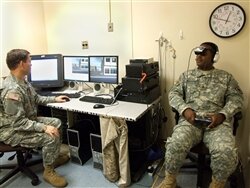Treating PTSD In Virtual Iraq
September 29, 2008
Often when someone suffers from PTSD, they attempt to avoid sounds, smells, places and things that remind them of the traumatic event that they experienced. They avoid talking about the incident, in the false hope that the images, sounds and feelings will eventually go away. Often that is not the case and many end up suffering needlessly, by not getting help in dealing with it.
According to a study that was released in April, nearly 20% of veterans returning from Iraq and Afghanistan are suffering from symptoms of PTSD. Those symptoms can cover a myriad of emotional and behavioral changes. Some experts feel that by facing their demons head on, that Troops suffering from PTSD can finally learn to release the effects of their disorder.1
At Walter Reed, thousands of miles from the combat zones, are three computers. One has a cord that attaches to a pair of goggles, a set of stereo headphones and machines that create motion and scent. Using this equipment, doctors there are walking Troops afflicted with PTSD, through an interactive experience called “Virtual Iraq.”
“You feel like you’re doing to die. Your heart’s beating out of your chest, your blood pressure’s going up and you want to just get away from it all,” Dr. Michael J. Roy, the director of Military Internal Medicine who oversees Virtual Iraq said of the treatment. “But you can make it through it. And you realize you’re going to be OK.”2
Traditionally, when a person is treated for PTSD, their doctors may use what is known as imaginal therapy. Using this form of treatment, doctors have the patient close their eyes and then imagine the traumatic experience and provide a first hand account of it. They are asked to describe what they saw, heard, and smelled. Often however, the attempt to protect oneself from the trauma, does not allow the individual to remember much of the traumatic moments in detail.
“It works well for those who can do that, but one of the cardinal features of PTSD is avoiding the trauma,” said Roy, a medical internist and Army Colonel. “So you’re asking somebody who wants to avoid any reminder, ‘Tell me everything you can about what happened.’ If you can do that, great - there’s a good chance you’re going to be cured. But are you going to be able to do it? Are you going to put up with it and keep coming back? A lot of people don’t.”3
Virtual Reality has been tested in other hospitals, with very good results. It’s great to see it expanding to other military medical centers. Each and every tool doctors have, to help those suffering from PTSD, to get better, is that many more of our Troops that can be helped in overcoming PTSD. I think this program, along with some of the other non-traditional therapies are going to be the answer to helping the Troops who suffer from PTSD. As I find more information, I’ll make sure to report it here.
- http://www.defenselink.mil/news/newsarticle.aspx?id=51297 [↩]
- http://www.defenselink.mil/news/newsarticle.aspx?id=51297 [↩]
- http://www.defenselink.mil/news/newsarticle.aspx?id=51297 [↩]
Comments
One Response to “Treating PTSD In Virtual Iraq”
Got something to say?


 Subscribe
Subscribe



[...] Treating PTSD In Virtual IraqAccording to a study that was released in April, nearly 20% of veterans returning from Iraq and Afghanistan are suffering from symptoms of PTSD. Those symptoms can cover a myriad of emotional and behavioral changes. … [...]